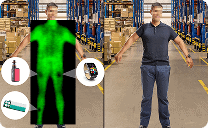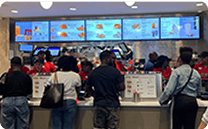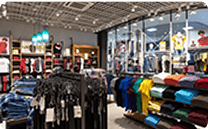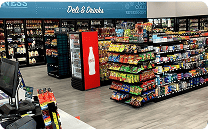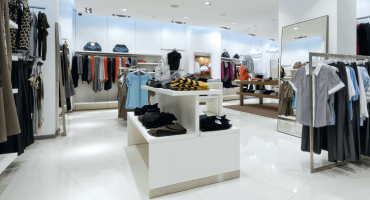In This article
Introduction
To operate a successful and profitable business, retailers must maximize merchandise sales and provide excellent customer service. Both goals are achievable with a focus on service efficiency in retail. Although customers always want quality products at competitive prices, it is often the checkout or transaction process where customer satisfaction can suffer the most. A 2024 study found that wait times in retail stores increased by 22% since 2023. When customers are unhappy with waiting longer, much of the goodwill created by offering “quality products at competitive prices” is lost, and many may think twice about returning.
Service efficiency in retail can take many forms, including simplifying the checkout process, offering multiple payment options, utilizing self-checkout kiosks, using clear signage, and having adequately staffed stores. By reducing customer wait times, more transactions occur in a given period, the process is smoother, and everyone experiences less stress.
Why Service Efficiency in Retail Matters
In many retail settings, customers often enjoy browsing leisurely and taking their time to make selections, checking sizes and colors, and comparing other products. However, they expect a speedy transaction process when they’re ready to check out. Therefore, reducing wait times in stores can foster customer loyalty and enhance the retailer-customer relationship, ultimately leading to increased sales.
The relationship between a faster retail checkout speed and reducing shopping cart abandonment takes various forms:
- A streamlined checkout process with fewer steps contributes to shorter wait times.
- Fewer employee-customer interactions remove possible friction points.
- Customers who experience a shorter checkout time are more likely to perceive a store’s brand as efficient.
- Customers may also perceive a store with a faster retail checkout speed as being very customer-focused.
Common Challenges Affecting Checkout Times
As humans, our interactions, including those when making a purchase at a retail store, aren’t always smooth. Several factors can create challenges in reducing customer wait times. Although some of these challenges are due to issues that arise during the checkout process, others stem from poor planning, inadequate training, a lack of management oversight, and outdated systems.
- Customers will quickly become frustrated when they are stuck in a long wait line due to an understaffed checkout counter and perceived workflow inefficiencies.
- The stress of having too few checkout employees can lead to transaction mistakes and add time to the checkout process for corrections.
- Service efficiency in retail relies on point-of-sale (POS) systems and payment-processing technologies that can experience technical issues.
- Customers value faster retail checkout speed, but they aren’t always prepared when they’re ready to check out. Asking product and pricing questions can also slow the checkout line.
Strategies for Reducing Wait Times in Stores
Of the several strategies for reducing customer wait times, not all of them relate directly to the checkout process. Some are the foundation for a better customer experience throughout their shopping trip, from arrival to product selection to checkout. Overlooking these “pre-checkout” strategies can result in dissatisfied customers regardless of the speed and ease of the checkout process.
- First among these foundational strategies is a store layout that separates the merchandise and shopping areas from the checkout area. Adding crowd control stanchions or dividers can enhance checkout speed.
- Employee training should also focus on facilitating faster and more accurate transactions while maintaining excellent customer service.
- Improving retail line management helps employees be more efficient during checkout and reveals which employees need remedial training.
- Making sure barcode tags on merchandise are positioned for quick scanning.
- Stores with high foot traffic and customers who make quick purchases may benefit from express lanes and self-checkout technology.
Improving Checkout Times with Technology
Just as advanced technologies have improved retail store security, reducing shrinkage and fraud, they can also revolutionize the checkout process, making it faster, simpler, and more satisfying for customers. This technological advancement paves the way for a more efficient and customer-centric retail experience.
- Artificial intelligence (AI) integrated into point-of-sale (POS) systems generates checkout data that, when analyzed, reveals when, where, how, and why checkout times are slow. This doesn’t mean replacing human cashiers, but rather empowering them with insights to improve the checkout process, thereby enhancing the average transaction.
- Many customers appreciate the convenience of self-checkout kiosks. These kiosks don’t replace cashiers, but they do reduce wait times and process customers more efficiently than traditional checkout with cashiers, thereby enhancing the overall customer experience.
- Advanced mobile payment technologies are helping to reduce checkout times. Employees can assist customers with purchases anywhere in the store. Mobile wallets, such as Apple Pay and Google Pay, as well as contactless payment systems, enable customers to make quick payments for their purchases.
- Various automation technologies, such as RFID tags, provide retailers with a real-time inventory picture, reducing merchandise handling and pricing during checkout. Employees are not spending time in the backroom fumbling with inventory.
Retail Line Management Best Practices
To maximize service efficiency in retail, store management must adopt a proactive approach to reducing customer wait times. Managers can achieve this goal by observing employees at checkout, training them to increase checkout speed while maintaining excellent customer service, and regularly reassessing store strategies to streamline the checkout process. Actively applying retail line management best practices is critical to improving checkout times.
- Managers can allocate some of their time to observe the checkout line and customers’ waiting reactions, identifying where bottlenecks occur. This real-time queue monitoring allows managers to adjust staffing and allocate other resources quickly.
- In retail stores with high foot traffic, installing digital signs that display current wait times can help increase retail checkout speed.
- Other retail line management best practices include virtual queuing, reserving a checkout spot for customers without requiring them to wait in line, and appointment-based shopping.
- Assign an employee to act as a “concierge,” directing customers to open checkout lanes and answering questions before they reach the counter. The employee can also interact with customers to alleviate any frustration caused by waiting.
Measuring and Sustaining Service Efficiency in Retail
Because elevating service efficiency in retail involves many moving parts, retailers must measure their progress in improving checkout times. Only with analysis and feedback can they expect to sustain their service efficiency. Evaluating and improving service efficiency directly relates to customer and employee satisfaction and loyalty. Inefficiencies are often readily apparent, leading to decreased foot traffic, revenues, and profitability.
- AI-driven POS systems demonstrate their value through the wealth of data they generate, including average checkout times and other key metrics. A thorough analysis of the data can show where service efficiency is lacking at checkout.
- Managers must observe the entire checkout process, evaluate the findings, and implement solutions related to technologies, employee training, or other improvements.
- Customer and employee surveys can help identify barriers to improving checkout times.
Conclusion
In today’s highly competitive retail environment, service efficiency in retail is often the difference between a profitable store filled with happy customers and one struggling financially and providing poor customer service. Customers are more aware than retailers think they are. They notice excessive wait times at checkout, even if they’re not ready to check out yet. Many consumers give retailers a one-strike option: one bad experience at checkout, and they may never return.
Retailers don’t have to live in this scenario. By implementing the right strategies, such as designated checkout areas, enhanced staff training, and adopting advanced technologies like AI-driven POS systems, retailers can streamline the checkout process and benefit from improved service efficiency in retail. To learn more about DTiQ’s solution for retail, visit our website.
